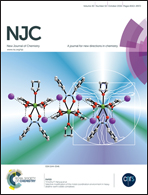Calixarenes with naphthalene units: calix[4]naphthalenes and hybrid[4]arenes†
Abstract
Macrocycles consisting of naphthalene units connected via methylene bridges offer certain advantages as macrocylic scaffolds as compared with parent calixarenes. These advantages originate from their electron rich and enlarged cavities. Additionally, macrocycles containing 1,3-bridged naphthalene units are dissymmetric and therefore they present interesting stereochemical features, including inherent chirality. We describe here a facile, one-step synthesis of two new calix[4]naphthalenes, by the condensation of 1,6-dimethoxynaphthalene with formaldehyde catalyzed by Brønsted acid (TFA). Additionally, we show the first example of hybrid[n]arene containing a 1,6-dimethoxynaphthalene unit and 1,3-dimethoxybenzene units obtained by a simple, one-pot condensation. The conformational and complexation properties were also studied for the resulting hybrid macrocycles.
![Graphical abstract: Calixarenes with naphthalene units: calix[4]naphthalenes and hybrid[4]arenes](/en/Image/Get?imageInfo.ImageType=GA&imageInfo.ImageIdentifier.ManuscriptID=C6NJ01736C&imageInfo.ImageIdentifier.Year=2016)

 Please wait while we load your content...
Please wait while we load your content...